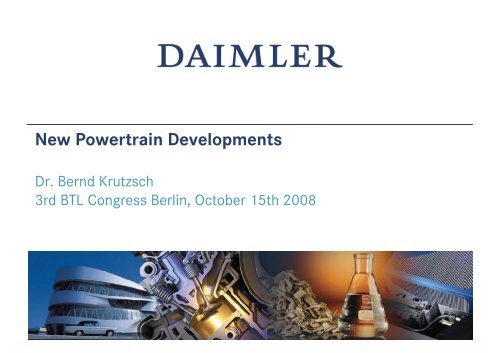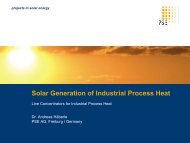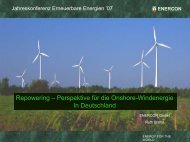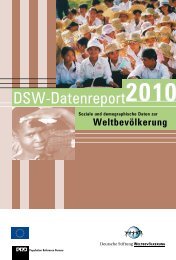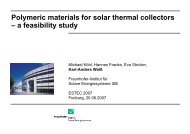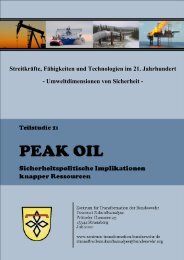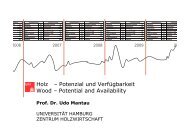Präsentation Krutzsch BTL 151008_finaloZ
Präsentation Krutzsch BTL 151008_finaloZ
Präsentation Krutzsch BTL 151008_finaloZ
You also want an ePaper? Increase the reach of your titles
YUMPU automatically turns print PDFs into web optimized ePapers that Google loves.
New Powertrain Developments<br />
Dr. Bernd <strong>Krutzsch</strong><br />
3rd <strong>BTL</strong> Congress Berlin, October 15th 2008<br />
1
Contents<br />
Challenges to Future Powertrains<br />
Daimler Road Map to Sustainable Mobility<br />
New Powertrain Developments of Mercedes Benz Car Group and Daimler Truck<br />
Group<br />
Assessment of Alternative Fuels<br />
Fuel Related Cooperations of Daimler<br />
Summary<br />
2
Global Challenges and Demands to Future Vehicles<br />
Global challenges Demands on vehicle<br />
[bn]<br />
[Gb/a]<br />
[bn vehicles]<br />
9<br />
6<br />
3<br />
0<br />
30<br />
20<br />
10<br />
0<br />
3<br />
2<br />
1<br />
0<br />
World Population<br />
Source: Prognosis UNO<br />
1950 2000 2050<br />
Limited Resources of Crude Oil<br />
9 bn<br />
~<br />
1950 2000 2050<br />
World Mobility<br />
Source:<br />
ASPO 2004<br />
13 GB/a<br />
~<br />
Source: Downs 2002<br />
1950 2000 2050<br />
~ 2.2 bn<br />
t<br />
Regulations<br />
• Safety<br />
• Consumption<br />
• Emissions<br />
• Noise<br />
Environment<br />
• Clean Air<br />
• Pollution<br />
• Resources<br />
• Recycling<br />
Strong efforts are required to meet all future vehicle related requirements<br />
Customer<br />
• Performance<br />
• Price<br />
• Current costs<br />
• Reliability<br />
3
Challenges Related to Emission Legislation<br />
Emission Legislation is becoming<br />
more and more stringent (robustness)<br />
Test procedure will be probably<br />
extended to whole engine map (off-cycle)<br />
To meet the future standards, fuels with closely restricted specifications and extensive<br />
Improvements in combustion and exhaust gas after treatment systems are obligatory<br />
4
Contents<br />
Challenges to Future Powertrains<br />
Daimler Road Map to Sustainable Mobility<br />
New Powertrain Developments of Mercedes Benz Car Group and Daimler Truck<br />
Group<br />
Assessment of Alternative Fuels<br />
Fuel Related Cooperations of Daimler<br />
Summary<br />
5
Daimler Road Map to Sustainable Mobility<br />
Mercedes-Benz Cars<br />
“Road To The Future”<br />
GTL Gas to Liquids<br />
<strong>BTL</strong> Biomass to Liquids<br />
CNG Compressed Natural Gas<br />
Conventional Fuel<br />
High in Sulfur<br />
high aromatics<br />
Technologies<br />
for a clean future of<br />
the premium<br />
automobile<br />
Daimler Fuel Roadmap<br />
Daimler Trucks<br />
„Shaping Future Transportation“<br />
yesterday today<br />
tomorrow<br />
Global Initiative<br />
for Environmentally<br />
Friendly Commercial<br />
Vehicles<br />
Hydrogen<br />
& Electricity<br />
2nd Gen. Biofuels (<strong>BTL</strong>, Biogas)<br />
1st Generation Biofuels<br />
Fossil based Synthetic Fuels (GTL)<br />
Compressed Natural Gas CNG<br />
Clean Conventional Fuels<br />
Daimler is addressing the challenge of finding a sustainable balance between economic,<br />
ecological, and social goals for future mobility<br />
6
Mercedes Benz Cars „Road to the Future“<br />
Maximum efficiency<br />
for vehicles with<br />
combustion engines<br />
BlueTEC<br />
CGI<br />
DiesOTTO<br />
BlueEFFICIENCY<br />
NGT<br />
Clean fuels for combustion engines<br />
Hybridization for<br />
further increase<br />
in efficiency<br />
HYBRID<br />
Range Extender<br />
Plug-In<br />
Energy sources<br />
for future mobility<br />
Emission-free driving<br />
with fuel cell /<br />
battery-drive vehicles<br />
F-CELL<br />
Battery-/E-Drive<br />
Emission-free driving<br />
7
Daimler Trucks „Shaping Future Transportation“<br />
Maximum efficiency<br />
for vehicles with<br />
combustion engines<br />
BlueTEC 4 and 5<br />
Clean fuels for combustion engines<br />
Hybridization for<br />
further increase<br />
in efficiency<br />
HYBRID BlueTEC Diesel Bus<br />
Plug-In Sprinter<br />
Energy sources<br />
for future mobility<br />
Emission-free driving<br />
with fuel cell /<br />
battery-drive vehicles<br />
F-CELL Citaro Bus<br />
Emission-free driving<br />
8
Contents<br />
Challenges to Future Powertrains<br />
Daimler Road Map to Sustainable Mobility<br />
New Powertrain Developments of Mercedes Benz Car Group And Daimler Truck<br />
Group<br />
Assessment of Alternative Fuels<br />
Fuel Related Cooperations of Daimler<br />
Summary<br />
9
Continuous Improvement<br />
Potentials for Combustion Engines<br />
Consumption<br />
Emissions<br />
Key Technologies<br />
Diesel engine Gasoline engine<br />
• Injection system<br />
• Combustion process<br />
• Homogenization<br />
• Turbocharger<br />
• Exhaust gas aftertreatment<br />
Target: Gasoline engines as efficient as diesel engines<br />
Diesel engines as clean as gasoline engines<br />
• Dethrottling<br />
• Direct Injection<br />
• Charging<br />
• Reduction of friction<br />
• Engine cooling management<br />
10
Future of Mercedes Benz Combustion Engines<br />
Gasoline engines<br />
Roll-out of V6-CGI engines on the way<br />
CLS:<br />
03/2006<br />
4-Cyl direct injection engine with benchmark<br />
properties to hit the market in 2009<br />
NEDC<br />
Fuel<br />
Efficiency<br />
9.7l<br />
(231g)<br />
E-Class:<br />
12/2007<br />
C-Class:<br />
Q3/2008<br />
E350<br />
(200 kW/350 Nm)<br />
-10%<br />
8.7l<br />
(208g)<br />
E350 CGI<br />
(215 kW/365 Nm)<br />
DiesOTTO<br />
Continuous improvements on our path to<br />
make diesels as clean as gasoline engines<br />
and gasoline engines as efficient as diesels<br />
DiesOTTO technology modules will<br />
be introduced step-by-step<br />
DiesOTTO performance in the F700:<br />
•175 kW<br />
•400 Nm<br />
•5.4 l/100 km (127g CO 2 /km)<br />
DiesOTTO: The Best of two engine worlds<br />
Diesel engines<br />
ongoing BlueTEC offensive<br />
(Passenger Cars & CVs)<br />
E320 BlueTEC<br />
(US): 2006<br />
World’s most powerful 4-Cyl. Diesel engine<br />
(500 Nm) will enable downsizing, starting in<br />
10/2008; prepared for hybridization and<br />
BlueTEC<br />
NEDC<br />
NOx<br />
Emissions<br />
E300 BlueTEC<br />
(Europe): 2007<br />
E320 CDI<br />
M-,R-,GL-Class<br />
(US): 2008<br />
E300<br />
BlueTEC<br />
11
BlueTEC, Key Elements of Clean Diesel Technology<br />
Control of<br />
emission<br />
components<br />
Reduction of<br />
engine out<br />
emissions<br />
Oxidizing catalyst<br />
Particulate filter<br />
BlueTEC with<br />
Advanced<br />
NSC<br />
BlueTEC with<br />
SCR<br />
BlueTEC is the key technology for ultra clean and efficient diesel vehicles<br />
Diesel engines as clean as gasoline engines<br />
Particulate filter<br />
and<br />
oxidation catalyst<br />
NO x<br />
aftertreatment<br />
12
Modular BlueTEC Technology<br />
BlueTEC1: Advanced DeNOx-Catalyst<br />
E 320 BlueTEC<br />
Vision CLS 320 BlueTEC<br />
•BlueTEC 1 market launch in passenger car<br />
on US market in October 2006 in E 320 sedan<br />
•BlueTEC 1 in passenger cars in Europe<br />
since end of 2007<br />
Oxidation-<br />
Catalyst<br />
Advanced<br />
DeNO x -Catalyst<br />
Particulate Filter<br />
BlueTEC<br />
SCR-<br />
Catalyst<br />
13
Modular BlueTEC Technology<br />
BlueTEC2: AdBlue-Injection<br />
Actros<br />
Vision GL 320 BlueTEC<br />
•BlueTEC is highly efficient and economical<br />
•BlueTEC is applicable worldwide<br />
•BlueTEC in commercial vehicles since 2005<br />
•GL 320 BlueTEC with SCR-AdBlue-aftertreatment<br />
is dedicated to comply with US federal BIN 5 and<br />
California LEV2.<br />
Oxidation-<br />
Catalyst<br />
Particulate<br />
Filter<br />
AdBlue-Tank<br />
BlueTEC<br />
AdBlue<br />
Metering Valve<br />
SCR-<br />
Catalyst<br />
14
Mercedes Benz 2 nd Generation DI–Technology<br />
•First gasoline engine with spray-guided DI combustion system<br />
with stratification mode – the future technology for gasoline<br />
engines<br />
•Robust spray-guided combustion system with piezo-injectors<br />
and 200 bar injection pressure.<br />
•Stratification mode possible also at higher engine loads and<br />
speeds due to multiplex injection<br />
•Exhaust aftertreatment system: TWC, NOx storage catalyst,<br />
NOx-Sensors<br />
•10% less fuel consumption at higher power output<br />
•Additional technology modules like direct start, multiple<br />
spark ignition, and turbocharger will further improve fuel<br />
consumption<br />
15
C 180 BlueEFFICIENCY – Improved Fuel Economy<br />
09/07<br />
7,4<br />
(178)<br />
W204<br />
KE18 MLred<br />
∆ vehicle<br />
Improvement Steps<br />
- 0,40<br />
∆ engine<br />
- 0,35<br />
∆ drive train<br />
- 0,17<br />
03/08<br />
6,5<br />
(156)<br />
W204<br />
KE16 ML<br />
Effect of all measures: - 0,9 l/100km<br />
Engine Data /Performance<br />
Power [kW]<br />
Torque [Nm]<br />
Compr. Ratio<br />
0 – 100 km [s]<br />
CO 2 [g/km]<br />
M271E18<br />
115<br />
230<br />
9,3<br />
9,6<br />
178<br />
M271E16<br />
115<br />
230<br />
9,3<br />
9,2<br />
156<br />
16
Mercedes Benz NGT Vehicles<br />
• Dual fuel powertrain unit<br />
• 115 kW gasoline/CNG<br />
• CO2: 135 g/km (NEDC), 17 %<br />
less than with gasoline<br />
• EU V Emission standard<br />
Vehicle range:<br />
• Max. 1000 km<br />
• Only CNG: 300 km<br />
• Only gasoline: 700 km<br />
E 200 NGT<br />
Since 2004 highest<br />
performance CNG PC<br />
engine (120 KW)<br />
by compressor charging<br />
B 170 NGT<br />
Starting from 06/2008,<br />
extension of Mercedes<br />
of Benz NGT fleet in the<br />
compact class segment<br />
Sprinter 316 NGT<br />
Starting from 05/2008,<br />
program addition in the<br />
segment of the light<br />
commercial vehicles for<br />
carriage of goods and<br />
person<br />
17
Contents<br />
Challenges to Future Powertrains<br />
Daimler Road Map to Sustainable Mobility<br />
New Powertrain Developments of Mercedes Benz Car Group And Daimler Truck<br />
Group<br />
Assessment of Alternative Fuels<br />
Fuel Related Cooperations of Daimler<br />
Summary<br />
18
Complex Impacts on Diverse Alternative Fuel Picture<br />
GHG saving<br />
Vehicle-user<br />
preferences<br />
Sustainability<br />
criteria<br />
Fuel production<br />
and supply<br />
requirements<br />
LPG<br />
Methanol<br />
Ethanol<br />
Biodiesel<br />
ETBE /<br />
MTBE<br />
E-Diesel<br />
DME<br />
Butanol<br />
OEM<br />
requirements<br />
Stringent<br />
emission<br />
standards<br />
Political Targets<br />
(FAME)<br />
HVO<br />
GTL<br />
Climate impacts<br />
Competition<br />
of farm land<br />
utilization<br />
Gas<br />
Liquid<br />
Alternative Fuel Options<br />
Today<br />
CNG<br />
Vegetable<br />
Oil<br />
Biogas<br />
SNG<br />
CTL<br />
Future<br />
<strong>BTL</strong><br />
Most relevant fuel option<br />
Uncertainties in alternative fuels supply and demand will complicate future engine<br />
development<br />
H 2<br />
Competition<br />
of biomass<br />
utilization<br />
19
Biofuel Assessment (Key Figures)<br />
Ethanol<br />
Biodiesel<br />
Synfuels<br />
Gaseous fuels<br />
Wheat (EU)<br />
Corn (USA)<br />
Sugar cane (Bra)<br />
Ligno cellulose (straw)<br />
Rape (EU)<br />
Soya (USA)<br />
Jatropha (eroded land in India)<br />
HVO (from palm oil)<br />
<strong>BTL</strong><br />
Biogas<br />
HVO: Hydrotreated Vegetable Oil<br />
<strong>BTL</strong>: Biomass to Liquid<br />
Competition to<br />
food and feed<br />
direct<br />
Indirect*) No<br />
1<br />
2<br />
*) land use competition<br />
3<br />
4<br />
Vehicle range<br />
0<br />
km/ha<br />
50T<br />
km/ha<br />
100T<br />
km/ha<br />
Source: meo/FNR<br />
Avoided GHG<br />
emission per ha<br />
0 t/ha 8 t/ha 16 t/ha<br />
1 Fast growing trees 2 Maize silage<br />
3 Waste wood 4 Bio waste<br />
<strong>BTL</strong>, Biogas from waste materials, Jatropha Biodiesel from eroded land and ligno cellulose<br />
ethanol are the most promising biofuels with no competition to food and feed<br />
1<br />
2<br />
2<br />
1<br />
Source: meo/FNR<br />
20
Contents<br />
Challenges to Future Powertrains<br />
Daimler Road Map to Sustainable Mobility<br />
New Powertrain Developments of Mercedes Benz Car Group and Daimler Truck<br />
Group<br />
Assessment of Alternative Fuels<br />
Fuel Related Cooperations of Daimler<br />
Summary<br />
21
Jatropha Cooperation:<br />
Daimler, Bayer CropScience, ADM<br />
Benefits of Jatropha as Biofuel<br />
Feedstock<br />
• Can be grown on marginal land -><br />
No competition with food production<br />
• Suitable feedstock for Biodiesel and HVO*<br />
• Significant reduction of CO 2 emissions<br />
• Employment opportunities in rural areas<br />
* Hydrotreated Vegetable Oil<br />
Start of Jatropha<br />
plantation<br />
Jatropha<br />
plantation after<br />
some years<br />
Project Objectives<br />
• Evaluate economic viability of commercial<br />
Jatropha biodiesel production in cooperation<br />
with industrial partners.<br />
• Support lobbying in India regarding quality of<br />
fossil fuels and biofuels.<br />
• Continue fleet test with Jatropha biodiesel<br />
blend in Mercedes-Benz vehicles (DC India).<br />
Fruits Kernels Jatropha<br />
Oil/Biodiesel<br />
JME<br />
On going JME<br />
vehicle test<br />
22
Daimler <strong>BTL</strong> Cooperation<br />
producing “SunDiesel” in cooperation with CHOREN Industries<br />
2001: Initial contact between Daimler & CHOREN<br />
2002: Start of Cooperation Daimler & CHOREN<br />
2002: Start of Cooperatien VW & CHOREN<br />
2005: Shell acquisition of CHOREN share<br />
2007: Daimler/VW acquisition of CHOREN share<br />
SunDiesel:<br />
The cleanest biofuel with enormous potential<br />
• 20 % of European Diesel consumption could be covered<br />
by biofuels<br />
• Up to 200 million tons of CO 2 emission in Europe could<br />
be prevented annually<br />
• Particulate emissions reduced by up to 50 %<br />
23
Challenge Bibendum Shanghai 2007<br />
World´s premier event in support of sustainable road<br />
mobility organized by Michelin<br />
smart fortwo SunDiesel became CO 2 Champion<br />
24
Thank you for your attention !<br />
25


